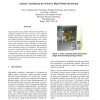Free Online Productivity Tools
i2Speak
i2Symbol
i2OCR
iTex2Img
iWeb2Print
iWeb2Shot
i2Type
iPdf2Split
iPdf2Merge
i2Bopomofo
i2Arabic
i2Style
i2Image
i2PDF
iLatex2Rtf
Sci2ools
SIBGRAPI
2005
IEEE
2005
IEEE
Analytic Antialiasing for Selective High Fidelity Rendering
Images rendered using global illumination algorithms are considered amongst the most realistic in 3D computer graphics. However, this high fidelity comes at a significant computational expense. A major part of this cost arises from the sampling required to eliminate aliasing errors. These errors occur due to the discrete sampling of continuous geometry space inherent to these techniques. In this paper we present a fast analytic method for predicting in advance where antialiasing needs to be computed. This prediction is based on a rapid visualisation of the scene using a GPU, which is used to drive a selective renderer. We are able to significantly reduce the overall number of anitialiasing rays traced, producing an image that is perceptually indistinguishable from the high quality image at a much reduced computational cost.
Computer Graphics | Fast Analytic Method | Global Illumination Algorithms | SIBGRAPI 2005 | Significant Computational Expense |
| Added | 25 Jun 2010 |
| Updated | 25 Jun 2010 |
| Type | Conference |
| Year | 2005 |
| Where | SIBGRAPI |
| Authors | Peter Longhurst, Kurt Debattista, Richard Gillibrand, Alan Chalmers |
Comments (0)

